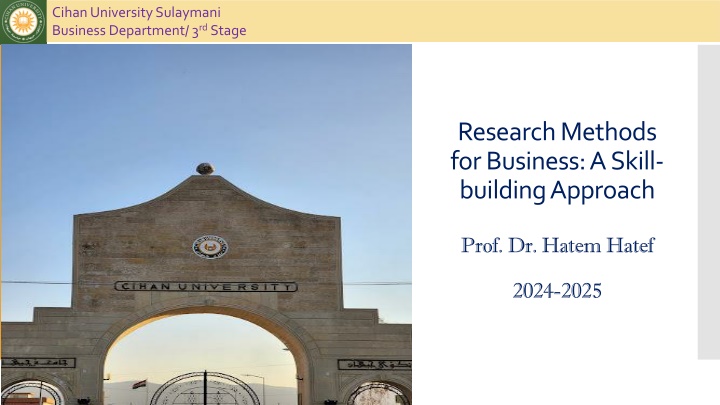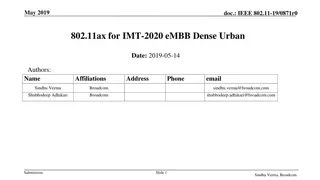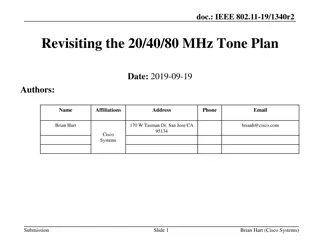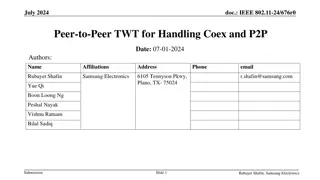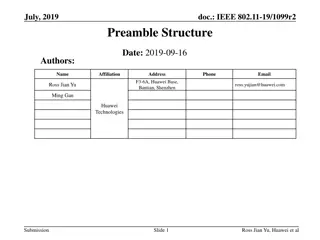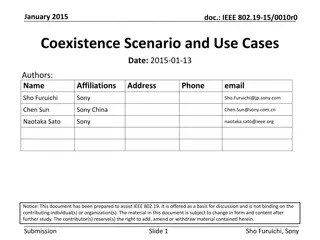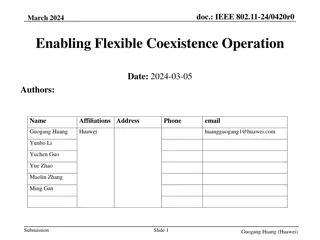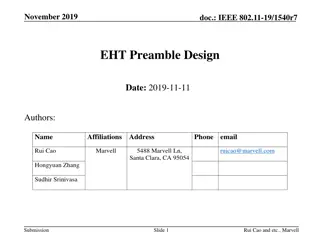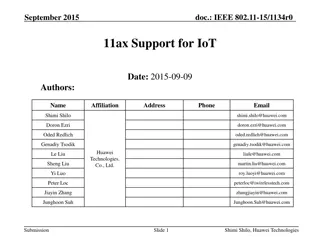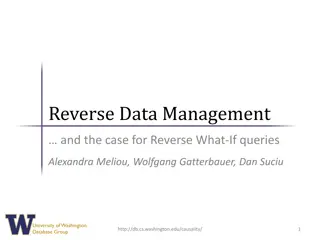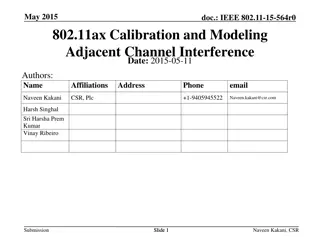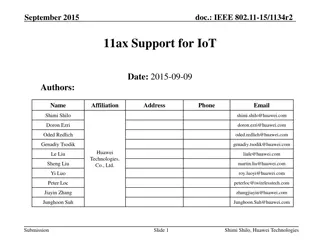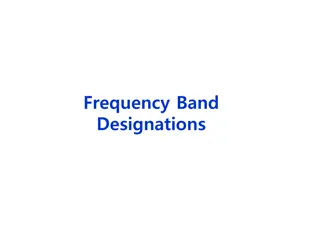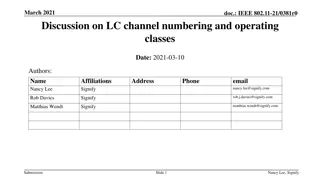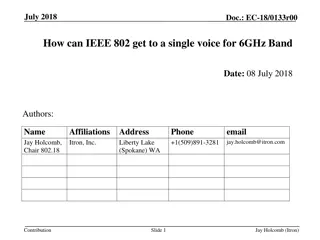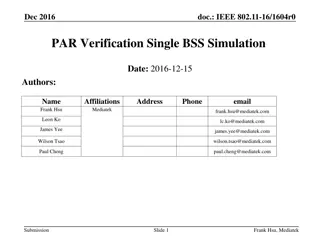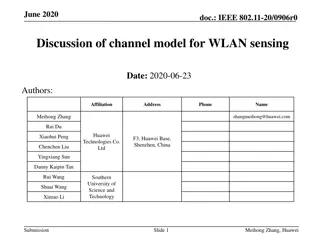Improving Coexistence Between IEEE 802.11ax and 802.15.4 in 6GHz Bands
This document discusses ideas and analysis for enhancing coexistence between IEEE 802.11ax and 802.15.4, focusing on the use of 6GHz bands. It includes brainstorming suggestions, comments on system scope changes, and considerations for coexistence with non-IEEE 802.11 systems, particularly 802.15.4 HRP_UWB and LRP_UWB. Various factors such as channelization options and spatial reuse are evaluated to promote positive coexistence strategies and understand potential impacts.
Download Presentation

Please find below an Image/Link to download the presentation.
The content on the website is provided AS IS for your information and personal use only. It may not be sold, licensed, or shared on other websites without obtaining consent from the author.If you encounter any issues during the download, it is possible that the publisher has removed the file from their server.
You are allowed to download the files provided on this website for personal or commercial use, subject to the condition that they are used lawfully. All files are the property of their respective owners.
The content on the website is provided AS IS for your information and personal use only. It may not be sold, licensed, or shared on other websites without obtaining consent from the author.
E N D
Presentation Transcript
Cihan University Sulaymani Business Department/ 3rd Stage Research Methods for Business: A Skill- building Approach Prof. Dr. Hatem Hatef 2024-2025
Research Methods for Business: A Skill-building Approach Book by Roger Bougie and Uma Sekaran
WHAT IS RESEARCH? Chapter one Introduction to research Research, is simply the process of finding solutions to a problem after a thorough study and analysis of the situation factors
1. Analyze and describe research methods utilized in the field of Accounting and Business.. LEARNING TARGETS
I CAN 1. I can analyze and describe research methods utilized in the field of Accounting and Business. STATEMENTS
BUSINESS RESEARCH Business research can be described as a systematic and organized effort to investigate a specific problem encountered in the work setting, which needs a solution.
We can define business research as an organized, systematic, data-based, critical, objective, scientific inquiry or investigation into a specific problem, undertaken with purpose of finding answers or solutions to it. DEFINITION OF BUSINESS RESEARCH
Is sufficient time available? Yes When Should When Should Business Business Research be Research be Undertaken? Undertaken? Is information inadequate? Do not NO undertake Business Research Yes High importance of decision? Yes Research benefits greater than costs? Undertake Business Research
COST VALUE Value and Costs of Undertaking Business Research 1. Research Costs 1. DecreasedUncertainty 2. Delay in Making Business Decisions 2. Higher Likelihood of Correct Decisions 3. Disclosure of Information to Rivals 3. Better Business performance 4. Higher Profits 4. Possibility of Error 5. Better Reputation
SOME SOME COMMONLY COMMONLY RESEARCHED RESEARCHED AREAS AREAS IN ACCOUNTING ACCOUNTING Area Area 1. Factors affecting the profit of the company . 2. Factors determine the variable cost of the company IN 3. Factors influencing depreciation.
Basic research fundamental pure Applied research TYPES TYPES OF BUSINESS BUSINESS RESEARCH: RESEARCH: APPLIED APPLIED AND BASIC BASIC OF Research done with the intention of applying the results of the findings to solve specific problems currently being experienced in an organization Research done chiefly to make a contribution to existing knowledge AND
Managers with knowledge of research have an advantage over those without Knowledgeable about research and research methods helps professional managers to: Identify and effectively solve minor problems in the work setting Know how to discriminate good from bad research Appreciate and be constantly aware of the multiple influences and multiple effects of factors impacting on a situation Take calculated risks in decision making, knowing full well the probabilities associated with the different possible outcomes. Prevent possible vested interests from exercising their influence in a situation. Related to hire researchers and consultants more effectively. Combine experience with scientific knowledge while making decision. 1) 2) 3) MANAGERS AND RESEARCH 4) 5) 6) 7)
Managers often need to engage a consultant to study some of the more complex, time consuming problems that they encounter THE THE MANAGER MANAGER AND AND THE CONSULTANT CONSULTANT- - RESEARCHER RESEARCHER THE
During their careers, it often becomes necessary for managers to deal with consultants, so while hiring researchers or consultants the manager should make sure that: The roles and expectations of both parties are made explicit. Related philosophies and value systems of organization are clearly stated and constraints, if any, are communicated. A good rapport (relationship) is established with the researchers, and between the researchers and the employees in the organization, enabling the full cooperation of the latter. 1. The Managers Researcher Relationship 2. 3.
Some organizations have their own consulting or research department, which might be called the management services department, the organization and methods department, R & D (research and development department) INTERNAL INTERNAL CONSULTANTS CONSULTANTS / / RESEARCHERS RESEARCHERS 1 1- -2 2
Advantage of internal consultants/ Disadvantage of internalconsultants researchers / researchers 1. Accepted by the employees 2. Less time to understandthe structure, work system 3. They are available to implementtheir recommendations, and deal with any bugs 4. Less cost 1. Fall into a stereotyped way of looking. 2. Scope of certainpowerful groups in the organization to influence certain facts. 3. Not perceived as experts 4. Biases of the internal research team INTERNAL CONSULTANTS / RESEARCHERS 2-2
Advantage of external consultants / researchers Disadvantage of external consultants / researchers 1. Wide range of experience 2. Have more knowledge of current sophisticated problem solving 1. The cost is high 2. Much time to understand the organization 3. Additional fees for implementatio n EXTERNAL CONSULTANTS / RESEARCHERS
Ethics in business research refers to a code of conduct or expected societal norm of behavior while conducting research. ETHICS ETHICS AND BUSINESS BUSINESS RESEARCH RESEARCH AND
CHAPTER TWO SCIENTIFIC INVESTIGATION
1. Purposiveness Started the research with a definite aim or purpose 2. Rigor Rigor connotes carefulness, scrupulousness, and the degree of exactitude in research investigations THE HALLMARKS OF SCIENTIFIC RESEARCH 1-3 3. Testability The manager or researcher develops certain hypotheses on how employee commitment can be enhanced, be tested by applying certain statistical tests to the data collected for the purpose then these can
4. Replicability The results of the tests of hypotheses should be supported again and yet again when the same type of research is repeated in other similar circumstances. 5. Precision and confidence Design the research in a manner the ensures that our findings are as close to reality Precision: reflects the degree of accuracy or exactitude of the results on the basis of the sample, to what really exists in the universe. Confidence: refer to the probability that our estimations are correct, it is important that we can confidently claim that 95% of the time our results will be true and there is only a 5 % chance of our being wrong. THE HALLMARKS OF SCIENTIFIC RESEARCH 2-3
6. . Objectivity The conclusion drawn through the interpretation of the results of data analysis should be based on facts of the findings derived from actual data, and not on our own subjective or emotional values. 7. Generalizability Refers to the scope of applicability of the research findings in one organizational setting to other settings THE HALLMARKS OF SCIENTIFIC RESEARCH 3-3 8. Parsimony Simplicity in explaining the phenomena or problems that occur, and in generating solutions for the problem,and it can be introduced with a good understanding of the problem and the important factors that influence it.
The The Scientific research pursues a step by- step, logical, organized, and rigorous method to find a solution to a problem Hypothetico Hypothetico- - deductive deductive Method Method
THE SEVEN-STEP PROCESS IN THE HYPOTHETICO- DEDUCTIVE METHOD 1-3
1. Identify a broad problem areaA drop in sales, frequent production interruptions, and the like, could attract the attention of manager and catalyze (encourage) the research project THE SEVEN- STEP PROCESS IN THE HYPOTHETICO- DEDUCTIVE METHOD 2-3 2. Define the problem statement Problem statement that stats the general objective of the research should be developed 3. Develop hypotheses In this step variable are examined as to their contribution or influence in explaining why the problem occurs and how it can be solved. 4. Determine measures Unless the variables in the theoretical framework are measured in some way, we will not be able to test our hypotheses.
5. Data collection Data with respect to each variable in the hypothesis need to be obtained. 6. Data analysis In the data analysis step, the data gathered are statistically analyzed to see if the hypotheses that were generated have been supported THE SEVEN- STEP PROCESS IN THE HYPOTHETICO- DEDUCTIVE METHOD 2-3 7. Interpretation of data (results) Now we must decide whether our hypotheses are supported or not by interpreting the meaning of the results of the data analysis
